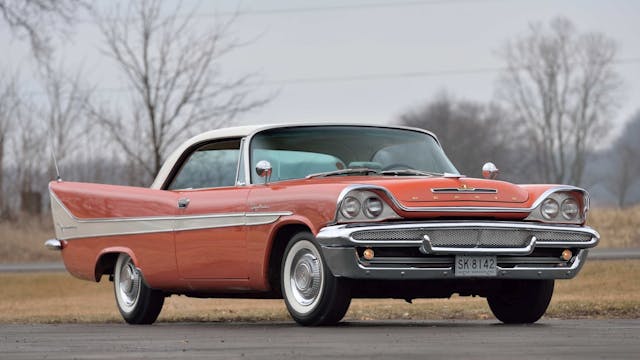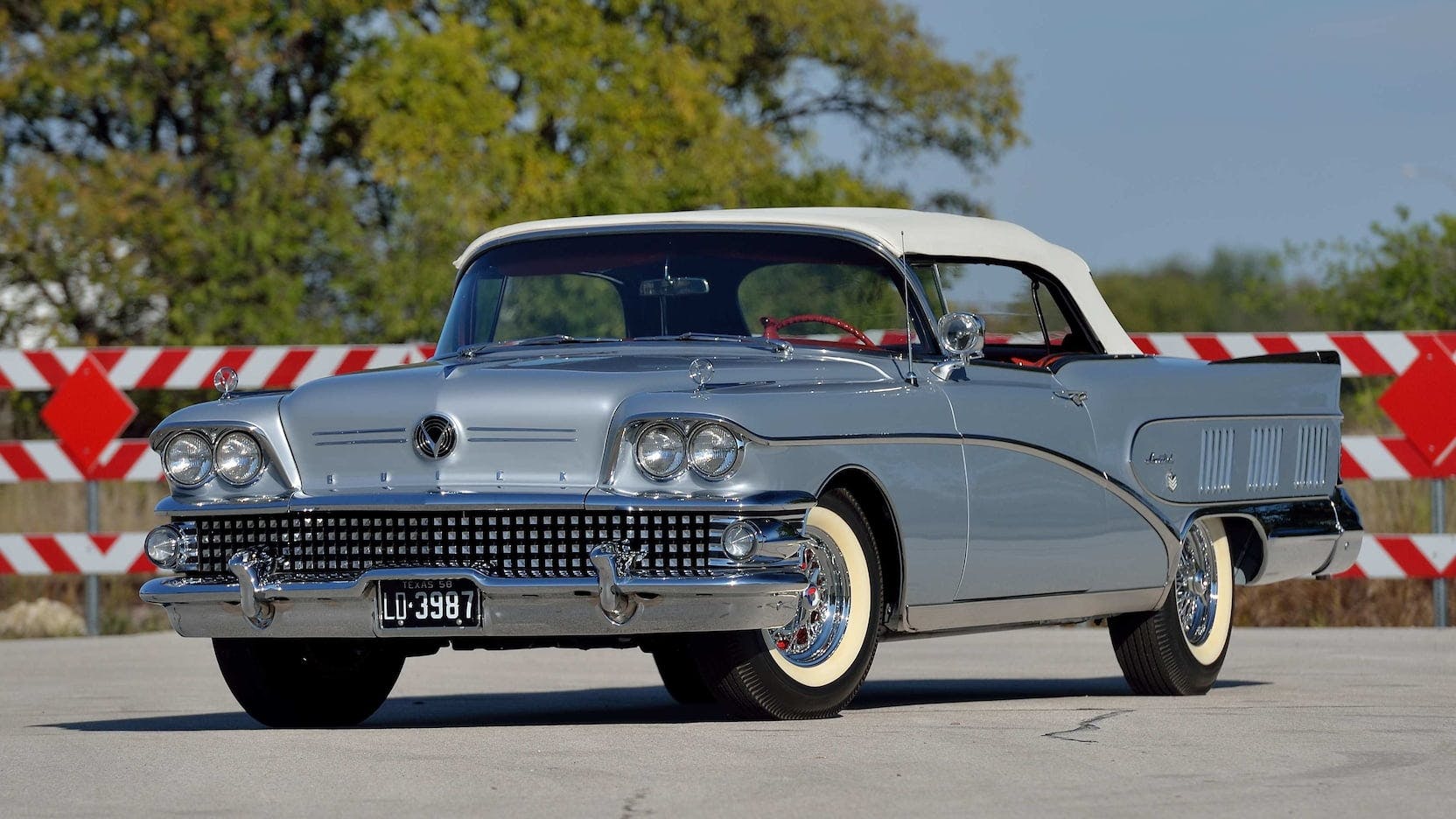Media | Articles
How the 1958 economic recession put Edsel and DeSoto over the edge
There’s a good chance you’re reading this while cooped up at home—at least, more than usual. A consequence of the COVID-19 pandemic is the world’s most volatile economic climate in more than a decade, which is already yielding a host of unwelcome surprises to the automotive industry.
Of course, this is far from the first time that an unpredictable economic environment has hampered the American auto industry. The 1958 recession sounded the death knell for two mid-tier American brands that were already dealing with problems of their own—Edsel and DeSoto.
For those of you whose grasp of economics ebbs and flows, here’s a quick definition of terms. A recession is a decline in economic activity triggered by a confluence of economic events. In American-centric terms, a recession is a decline in real GDP, income, industrial production, and wholesale-retail sales, combined with a rise in unemployment over several months or more.
The 1958 recession officially started in August, 1957, and ended in April, 1958, with 2.5 million unemployed by December of ’57, according to the Miami News (on December 8, 1957). Department store sales dropped five percent, and sales of manufactured goods fell 12.4 percent. By July of ’58, unemployment peaked at more than 5.5 million.
At the time, it was common to trade in your car every few years. When the recession rolled around, consumers decided to hold on to their cars for a bit longer. Due to the high unemployment rate, middle-class marques suffered the most, and sales plummeted approximately 36 percent. Of course, the steel industry was hurting as well; its capacity declined to 81 percent.
Marketplace
Buy and sell classics with confidence
Desperate times didn’t squelch creative thinking, however, and two car dealers in Cleveland came up with a promotional idea to boost car sales. From February 24 to March 1, 1958, the “You Auto Buy Now” campaign moved $15 million worth of new and used cars. Dealers in over 200 cities took notice, and the Automobile Merchants Association of New York, Inc. kicked off a similar drive at Madison Square Garden two months later. According to the Ventura County Star-Free Press on May 10, 1958, weekly sales ballooned by 101 percent over a week-long promotion in Saginaw, Michigan. Sales in Detroit jumped 240 percent in 12 days. In Flint, new car sales tripled.
Even as economic fortunes swung toward an all-time low, 1958 represented the apex of Atomic Age design and styling excess from Detroit. General Motors introduced Golden Anniversary models that, in the case of Oldsmobile and Buick, featured chrome slathered on with a trowel. Ford’s new series of Lincoln and Continental models lacked the elegance and grace of previous years’ models, trading smooth curves for glitzy fins and aggressive creases. Mercury models continued to be laden with kitsch. (Though Chrysler Corporation vehicles only wore facelifts, they retained the same forward-thinking designs that captured the industry’s imagination in 1957.)
A reaction against Detroit’s automotive extravagance had already been brewing. As told in the El Paso Herald-Post on June 3, 1958, a spokesman for the Society of Motor Manufacturers and Traders (U.K.) suggested that America consumers thought cars were getting too big; they wanted cars that were easier to park and less greedy for gas. Not only did imported offerings sport a smaller footprint and more conservative appetite for fuel; the prestige of a foreign car also appealed to fledgling two-car families. Though a funny little car from Germany, the VW Beetle, was making waves, imports enjoyed only 8.1 percent of the overall market. The domestic market began responding to consumer demand, as shown by the increasing popularity of Rambler, and in 1959, the Studebaker Lark appeared to great consumer satisfaction.
Though bright spots in the car industry did exist in the 1958 recession, two brands bore the brunt of the economic downturn. Within a few years, both would be discontinued.
Edsel

To the layperson, Edsel is a car from the 1950s synonymous with “flop.” Dig a little deeper, and you might conclude that Edsel was a victim of the recession, but even that doesn’t tell the whole story.
General Motors had an established reputation as a juggernaut in the 1950s, but it wasn’t unusual for a competitor to think, “We can compete toe to toe with the General.” Ford Motor Company felt up to the task.
Even by 1950s standards, GM’s lineup appeared bloated in 1958, but so did Ford’s development of the Edsel. Though it already boasted the well-established brands of Ford, Mercury, and Lincoln, FoMoCo had just formed the Continental brand for the ultra-luxurious Mark II in 1956. The powers-that-be at Dearborn thought there was more opportunity. Enter Edsel.
While hemming and hawing about what to call its new automotive brand, Ford hired a noted poet to draft several suggestions. “Utopian Turtletop” was one candidate, which somehow makes the uninspiring name of “Edsel” less awkward. Unfortunately, its tortuous birth foreshadowed Edsel’s disastrous fate.
Edsel came out with four models: the Ranger, the Pacer, the Corsair, and the Citation. The first two rode on a 118-inch wheelbase shared with the Ford Fairlane. The latter two relied on a 124-inch platform shared with mid-tier Mercurys (wagons used Ford’s 116-inch unit). Herein lies one of the Edsel’s biggest tragedies: despite all the market research that Ford put into it, the marketing hype spelled Edsel’s doom.
True, the best research couldn’t foresee the extent of the 1958 recession. However, Ford priced the four Edsel series overlapping the Ford Fairlane 500 and three of the four Mercury models, and this strategy proved to be pure cannibalization.
Edsel cut down its model range to the Ranger (now available with a six-cylinder) and the Corsair for 1959. Both Edsels used a 120-inch wheelbase (wagons an 118-inch). The Mercury-based segment of the series was discontinued. Ford also trimmed the gimmickry of the 1958 models, and the Edsel basically became a Ford with different styling. The “horse collar” grille carried on, but headlights floating in the flanking grille extensions gave it a more contemporary look. The unique “MEL” engine, standard on high-line Edsels in 1958, was no longer available.
For 1960, the Edsel series was reduced to the Ranger series. The design closely followed Ford’s, with the vertical grille relegated to the rubbish bin. Sometime in November 1959, Ford opted to pull the plug on Edsel. So it goes.
DeSoto

It’s somewhat amazing that DeSoto died not long after Virgil Exner’s “Forward Look” debuted in 1957, displaying styling that many consider the highlight of Chrysler design. However, history was not on DeSoto’s side.
The similar 1958 model fixed many of the quality issues that plagued the 1957s. Styling changes were subtle, with the most noticeable being redesigned side trim and standard quad headlights, with a tweaked front bumper and fluted rear bumper also being noteworthy. Models were the same as before, with the Dodge-based Firesweep at the bottom and the Firedome, Fireflite, and Adventurer stacked on top. Wedges were the new name of the game, with the Hemi disappearing from the spec sheet as all but the Firesweep utilized a new 361 (the Firesweep never had a Hemi, and for 1958 it made do with a 350 that was shared with some Plymouths and Dodges). Electronic fuel injection with 355 horsepower was an option for the Adventurer, but only a handful were built before it all came crashing down.

When 1958 sales were tallied, DeSoto production had plunged by almost 70 percent to 49,445. DeSoto never recovered. For 1960, the new Unibody DeSoto had been reduced to two models, the Fireflite and the Adventurer, and the latter was no longer a special performance model, even although a cross-ram 383 was available. Production was a hair over 26,000, which fell to 3034 when the Chrysler Corporation discontinued the marque in November, 1960.
DeSoto’s demise, of course, was due to completely different reasons than Edsel’s. Certainly Chrysler Corporation’s dealer structure can be partly blamed; DeSoto-Plymouth dealerships competed with other co-branded dealerships within the Chrysler Corporation. Another DeSoto problem was that the Chrysler Windsor was priced in DeSoto territory, pillaging sales by offering a more prestigious nameplate for the same money. Lastly, DeSoto consistently sold fewer vehicles than big-brother Chrysler. When the ’58 recession hit, fragile DeSoto stood little chance.






